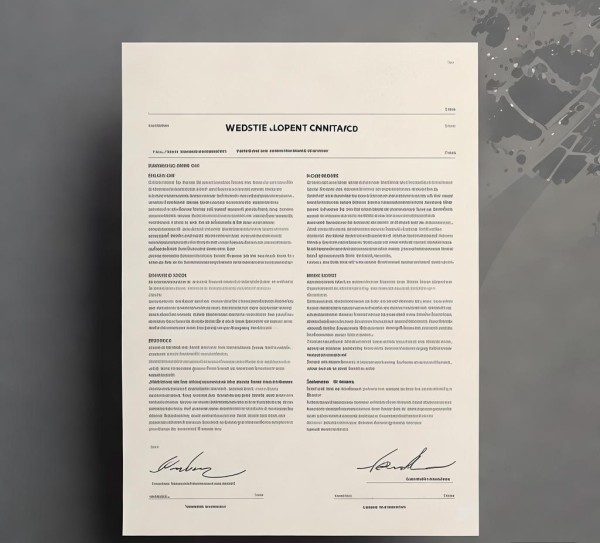Website Construction Contract English Version,,This contract outlines the agreement between [Your Company Name] and [Client's Company Name], detailing the terms for website construction services. The scope includes design, development, hosting, and maintenance of a website tailored to the client’s business needs. Payment terms are specified with milestones and deliverables clearly defined. Confidentiality clauses protect both parties' sensitive information. The contract also addresses dispute resolution mechanisms and termination conditions. This legally binding document ensures mutual understanding and commitment to the project's objectives.

Introduction
In the era of digital transformation, a robust online presence is indispensable for businesses aiming to thrive in a competitive landscape. A well-crafted website not only showcases products or services but also fosters customer interaction and engagement. To navigate the complexities of web development projects effectively, a detailed website construction contract is paramount. This article delves into the intricacies of drafting a comprehensive website construction contract in English.
1. Identification of Parties
The cornerstone of any contractual agreement lies in the precise identification of the parties involved. For a website construction contract, the key stakeholders are:
- Client: The entity or individual commissioning the website development services.
- Web Developer/Developer: The professional or firm tasked with constructing the website.
Ensuring the inclusion of complete names, addresses, contact details, and tax identification numbers for both parties is vital for transparency and accountability.
2. Scope of Work
This pivotal section delineates the specific tasks encompassed within the website development project. It should meticulously detail aspects like:
- Website Design: A thorough description of visual components, including layout, color palette, typography, and imagery.
- Content Creation: Clarification on whether content generation is part of the service package or if the client is responsible for providing the material.
- Development Features: Specification of any bespoke functionalities desired, such as e-commerce solutions, blogging integrations, or multimedia capabilities.
- Testing and Quality Assurance: Procedures for ensuring cross-browser and device compatibility through rigorous testing protocols.
- Launch and Deployment: Detailed plans regarding the go-live date and the deployment strategy.
3. Timeline and Milestones
Establishing realistic timelines and milestones is crucial for effective project management. This segment should articulate:
- Project Duration: Clearly defined start and end dates.
- Milestones: Key checkpoints where progress reviews occur, such as design approval, coding completion, and final quality assurance.
- Delays and Extensions: Provisions for adjusting the schedule due to unforeseen challenges or changes requested by the client.
4. Payment Terms
Defining payment arrangements is fundamental to avoiding potential disputes. This section should cover:
- Total Project Cost: The agreed-upon cost for the website development services.
- Payment Schedule: The structure for installment payments tied to specific project phases or upon completion.
- Penalties for Late Payments: Consequences for delayed payments by either party.
- Refund Policy: Guidelines for issuing refunds under certain conditions.
5. Intellectual Property Rights
Protecting intellectual property is essential. This section should clarify:
- Ownership of Website Content: Determination of who holds the copyright to the website’s content post-completion.
- Source Code and Backend Access: Whether the client will gain access to the website's backend and any associated restrictions.
- Third-party Licenses: Information regarding any third-party software or tools utilized during development.
6. Confidentiality Agreement
A confidentiality agreement safeguards sensitive information exchanged between the client and developer. This section should specify:
- Scope of Confidential Information: The types of data requiring discretion.
- Duration of Confidentiality: The period during which the information remains confidential.
- Consequences of Breach: Penalties for breaching the confidentiality agreement.
7. Warranty and Support
Providing warranties and post-launch support ensures the website performs optimally after its initial release. This section should address:
- Warranty Period: The timeframe during which the developer warrants the website’s performance.
- Post-Launch Support: Services offered after the website goes live, including bug fixing and technical assistance.
- 本文转载自互联网,具体来源未知,或在文章中已说明来源,若有权利人发现,请联系我们更正。本站尊重原创,转载文章仅为传递更多信息之目的,并不意味着赞同其观点或证实其内容的真实性。如其他媒体、网站或个人从本网站转载使用,请保留本站注明的文章来源,并自负版权等法律责任。如有关于文章内容的疑问或投诉,请及时联系我们。我们转载此文的目的在于传递更多信息,同时也希望找到原作者,感谢各位读者的支持!
